Phillip Island Walking Tracks
If you love nature and spectacular scenery, you will enjoy Phillip Island walking tracks.
Nearly all are suitable for normal fitness levels, although the Cape Woolamai tracks require a bit more stamina.
But take your time and they are manageable.
An off-island walking track well worth doing is the George Bass Coastal Walk from near San Remo to Kilcunda.
Times given for these walking tracks are for a leisurely, easy stroll with time to take in the scenery and wildlife, and to take photographs.
As well as your camera, don't forget binoculars, particularly if you are a keen bird watcher.
Rugged Cape Woolamai Scenery
The track at Swan Lake, the mangrove boardwalk at Rhyll Inlet and the Wallaby Walk at Oswin Roberts Reserve are suitable for wheelchairs or prams.
Take care however, as these paths are slightly rough in places with a bit of loose gravel.
Be on the alert in summer for snakes.
We have only one species on Phillip Island - the poisonous copperhead - and you might come across one sunning itself on a walking track.
Do not go near or antagonize snakes - usually they will just harmlessly slither away as they hear (or feel) your approach.
Before setting out on Phillip Island walking tracks, here are a few guidelines for your safety and to protect the environment:
- Keep to tracks
- Walk quietly to avoid disturbing wildlife
- Wear suitable clothing and footwear
- Take water
- Stay clear of cliff edges
- In summer, watch for snakes
- Do not bring dogs
- Take rubbish away with you
Enjoy Phillip Island walking tracks for yourself!
Cape Woolamai Faunal Reserve
Cape Woolamai Looking Towards The Pinnacles
The Cape Woolamai peninsula has three of the most rewarding Phillip Island walking tracks and are more challenging - some fitness is needed to complete them.
There are toilet facilities at the surf club building.
All walks start at Woolamai surf beach clubhouse so walkers will be walking in sand for a short time.
About 500 metres along the beach there are about 50 stairs up to the track.
Because of the need to walk along the beach, and then up the stairs, this walking track isn't suitable for prams or wheelchairs.
At the top of the stairs there is signage showing the way to the different walks.
During the walks look out for echidna and wallabies.
Sometimes animal tracks can be seen across the path. Try and identify the owner - lizard, bird, snake?
We have come across blue-tongue lizards sunning themselves next to the track.
Be aware of snakes - although I haven't seen one here, I have had reports from other walkers.
Birdwatchers can look for hooded plovers on the beach or perhaps white-bellied sea eagle or albatross on the wing.
Kestrels and kites are often sweeping across the cape on the lookout for prey.
In the evening from September to April, thousands of short tailed shearwaters return after their daily fishing to their rookeries on the cliff top – an amazing sight.
Have a close-up look at the shearwater rookeries as you pass. But don't step on the burrows - they are fragile. Not only will you destroy their habitat but you might twist an ankle.

The Pinnacles Walk is 4km return and will take about 2 hours. The path winds along the cliff top. Spend some time marvelling at the pink granite rock formation known as The Pinnacles.
Cape Woolamai Beacon Walk is 6.6km return and takes about 3.5 hours. It climbs to the highest point on Phillip Island – the beacon at 118 metres.
Take in the spectacular views of the southern coastline of the island and along the mainland coast towards Wilson’s Promontory.
Cape Woolamai Circuit Walk is 8km return – allow about 4.5 hours. This walk takes in the old pink granite quarry and jetty on Cleeland Bight.
Time the walk to be there at low tide as the quarry will not be accessible when the tide is high.
Continue along the beach for the track back across to Woolamai beach.
Or return to the main track of the Beacon Walk.
Further back up the road from the clubhouse there is the entry to the walk to Cleeland Bight. The walk is only about 300 metres.
At low tide walkers can walk from along the beach at Cleeland Bight to the old granite quarry and loop back via the woodland track to the beach and surf club clubhouse.

Remains of the Pink Granite Quarry at Cape Woolamai
Oswin Roberts Reserve
Oswin Roberts Reserve, the largest accessible woodland left on Phillip Island, is between Harbison Road and Cowes-Rhyll Road.
If you're looking for a tranquil Phillip Island walking track, this is the one for you.
The reserve was donated by Florence Oswin Roberts to preserve habitat for the island's koala population.
I like to start these Phillip Island walking tracks at the Harbison Road entrance as the car park is shady.
Harbison Road is off Coghlan Road, just north of the intersection of Phillip Island Road and Coghlan Road and is adjacent to the Koala Conservation Reserve.
From the car park take some time to admire the remnant
chicory kiln over the road. Visitors will see these dotted around the
island - a reminder of the once thriving and important chicory farming industry.
The best time to walk the three tracks here is early in the morning when swamp wallabies are out feeding but walk quietly.
Swamp Wallaby at Oswin Roberts Reserve
Early morning is also a perfect time to breathe in the fragrant
air and enjoy the silence, interrupted only by small birds twittering
among the trees or the raucous laughter of the kookaburra.
Look out also for koalas, lizards, echidna and, in summer, snakes. Birds include honeyeaters, parrots, pardalotes and thornbills plus many other species of Australian bush birds.
The walks are through eucalypt woodland with species such as eucalypt, sweet bursaria, paperbark and acacia.
Look also for kangaroo apple bushes - their mauve flowers or green/yellow fruit.
In spring/summer, thousands of black and orange butterflies which flutter among the spreads of yellow flowering goodenia bushes are a delight.
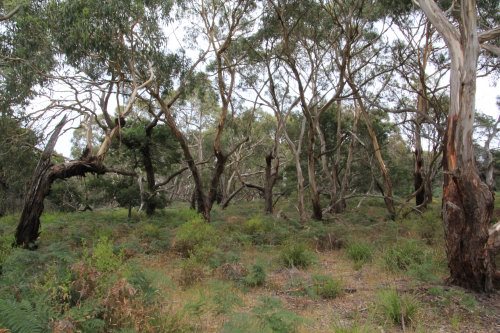
Enjoy Tranquil Phillip Island Walking Tracks at Oswin Roberts Reserve
Wallaby Walk is 1.1km return and takes about 30 minutes. This gravel or grassed track is suitable for wheelchairs or prams although some help may be needed at times.
Bush Bird Walk
is 2.5km return – allow an hour. This is a great track to observe
wallabies feeding. They are very shy but often will stand still if you
don't frighten them. Their "runs" (paths) can be seen through the low
vegetation.
Bay Views Walk is 4.5km return and will take about 2 hours as an easy stroll.
Apart from the three walks, visitors can also follow the signs to Conservation Hill and Rhyll Inlet.
Walk the right hand side (northbound) of the Bay Views Walk. Near the end there is a sign off to the right for the track to Conservation Hill.
Along this track you can see some of the edges of Rhyll Wetlands. Depending on the season there may or may not be water. Sometimes ibis and other waterbirds can be seen feeding in the swampy ground.
Once you reach Cowes-Rhyll Road, the track goes along parallel to the road for a few hundred metres before crossing over to Conservation Hill.
Rhyll Inlet and Conservation Hill
Park in the car park off Cowes-Rhyll Road. Toilet facilities are available.
Here there are Phillip Island walking tracks with a difference - one incorporating a boardwalk through mangroves.
Mangrove Boardwalk is 1.2 km return which will take about 45 minutes.
On this walk paperbark woodland meets mangroves. At low tide watch shore crabs scurrying in the mud and listen to the noise made by snapping shrimp as you follow the meandering boardwalk.
This walk is suitable for wheelchairs and prams.
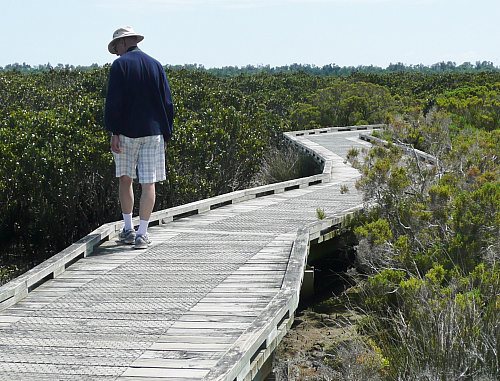
Mangrove Boardwalk at Rhyll
A popular Phillip Island walking track is the walk to Conservation Hill and McIlwraith Road, especially with bird watchers. The walking track is 4.5km return – allow about 2 hours.
Walking through the woodland with views over Rhyll Inlet is a special experience. Observe the many bird species in this important breeding ground.
In summer it is also a feeding ground for migratory birds from the northern hemisphere.
Another track connects walkers to the Oswin Roberts Reserve.
The walk starts to your left (looking towards the bush), is about 800 metres and takes about 15 minutes one way.
The walk is part gravel and part boardwalk. It could be managed with a pram but the gravel is loose in parts and there is one small steep hill.
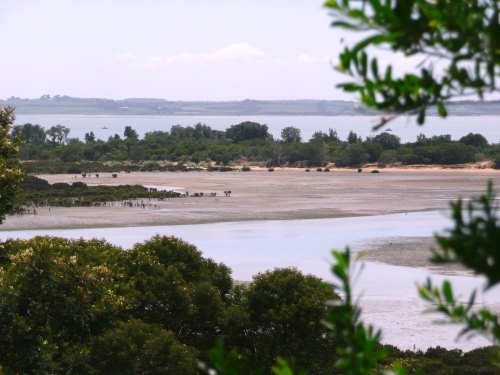
Looking Over Rhyll Inlet From the Walking Track
Visitors should take time to climb the Jack Oswin viewing platform to look over Rhyll Inlet to French Island.
If you have binoculars don't forget to bring them to view the teeming birdlife.
The boardwalk, although not far from the road, is through a lovely peaceful grove of paperbark trees.
Swamp wallabies may be spotted hiding in the shadows.
There are benches for resting.
At the end, walkers can cross the Rhyll-Cowes Road to continue on the trails in Oswin Roberts Reserve.
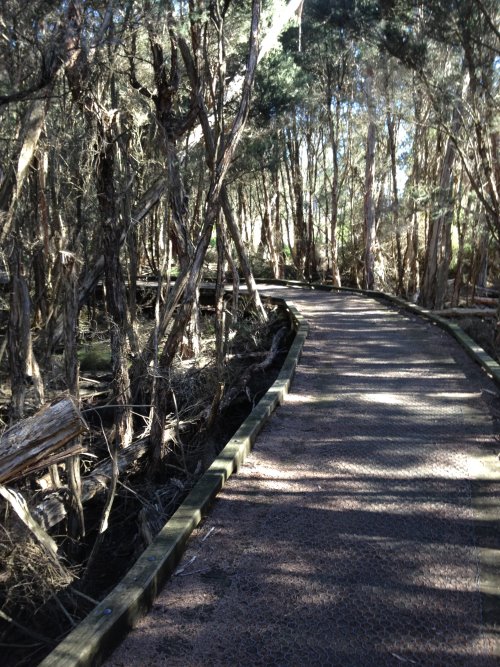
Paperbark Walk Near Rhyll Inlet
Scenic Estate Conservation Reserve
Once a site developed for a housing estate, Scenic Estate has now been returned to its original state. This has come about after years of work by the State Government, Bass Coast Shire Council, Parks Victoria and Phillip Island Nature Parks.
It is the newest member of all Phillip Island walking tracks.
The entrance is off Phillip Island Road, just before Surf Beach if you are coming from the east (or Woolamai) side of Phillip Island.
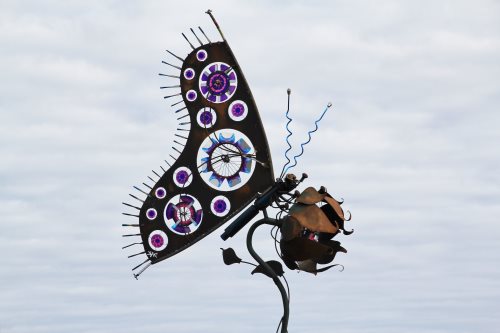
Butterfly Sculpture by David A Kopelman
The first thing to get the attention of visitors is the sculpture of a butterfly on a sweet bursaria flower. Made from recycled materials, parts of the sculpture move in the wind, acting like a wind vane.
Walk to the end of the new plantings and turn left to follow along the sand/dirt paths. These paths are suitable for prams and wheelchairs.
In total there are 1500 metres of tracks so the reserve is a good size for children to enjoy.
The first part of the reserve features a loop. We kept walking between the tea tree, turning right to reach the native grasslands and boardwalk area, leaving the wetland for the return journey.
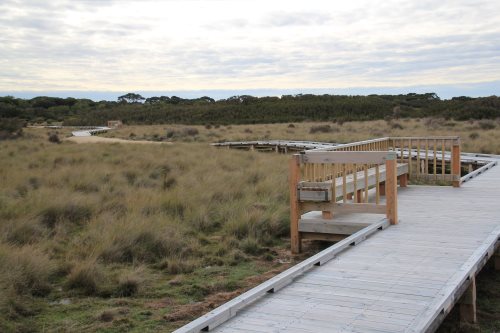
Boardwalk Over Native Grasslands at Scenic Estate
Through the grasslands there are nearly 200 metres of boardwalk. Take a rest on the seat along the boardwalk and listen to the cry of birds plus the loud croaking of frogs. We saw plovers, ibis, ducks and Cape Barren geese. Glimpses of farmland can also be seen.
Past the grassland there is another small loop through the coastal heath, including a picnic shelter, before reaching the shore of the Churchill Island Marine National Park. Here there is a great viewing platform with wonderful views to Churchill Island, farmland, Rhyll, and French Island.
We were there at low tide and saw heron, cormorant, oyster catchers and black swans feeding along the shore. Summer would bring many of the migratory birds which call the Ramsar listed wetlands of Phillip Island home.
There is another picnic shelter here and it would be a lovely spot for a summer picnic, under the shade of large trees.
For those interested in the marine history of Phillip Island, at low tide the wreck of the Minah can be seen across Swan Bay towards Rhyll.
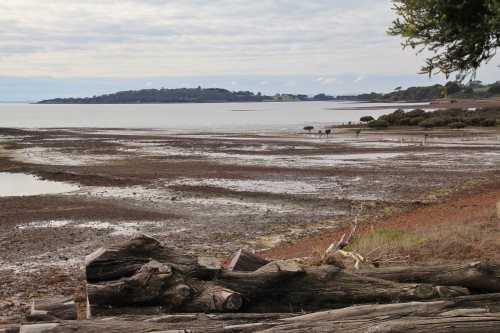
View to Churchill Island From Scenic Estate
On our way back we came across a shy swamp wallaby, one of the many who call Scenic Estate home!
The wetland has been planted with indigenous plants such as lilies and reeds. When these are grown this will be a special place.
The return walk also has nice views across to the dunes of Surf Beach.
Back near the entrance gate we were excited to see black-fronted dotterel darting along the grass to the left of the track.
Note that there are no toilets in the reserve.
The entrance and exit to Scenic Estate Conservation Reserve is badly situated. Near a hill, traffic visibility is limited. During the busy summer months it may be very difficult to safely turn right towards Cowes.
Pyramid Rock to Berrys Beach
Start at either end of this 5.4km return easy walk which will take about 1.5 hours. Of all Phillip Island walking tracks, this one has many special experiences.
Toilet facilities are available at both Pyramid Rock and Berrys Beach.
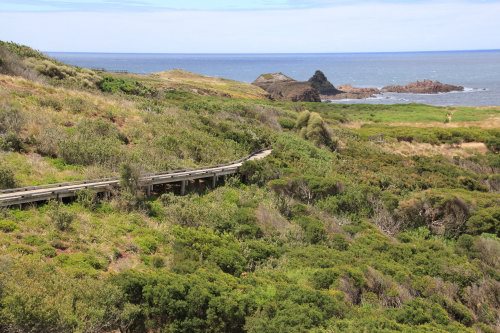
Boardwalk Near Pyramid Rock, Phillip Island - Part of the Walking Track to Berrys Beach
I start at Pyramid Rock but of course the walk can be done in reverse.
The wooden walkway in Storm Bay has great views of Pyramid Rock and the rugged basalt coastline. Try to spot a wallaby in the dense coastal vegetation.
The track follows along the cliff top with farmland on one side. On the horizon see huge ships heading for port in Melbourne.
The walk ends at Glamis Road at Berrys Beach.
This is one of my favourite Phillip Island walking tracks.
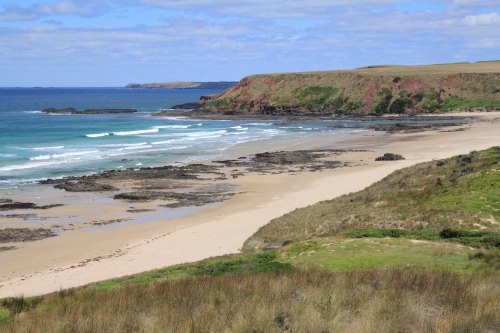
Berrys Beach
South Coast Walk
For this 4 km walk, organise a car to pick you up at whichever point you finish. The road runs between the Penguin Parade Visitor Centre and the Nobbies Centre.
Follow the road along the rugged southern coast with spectacular scenery of huge waves crashing over the black basalt rocks.
There
are several lookouts along the way - have a rest or admire the view
over Bass Strait and from The Nobbies to Cape Woolamai.
Remember, do not leave the road or approach the cliff tops, which can be unstable.
This Phillip island walking track is also a lovely drive.
Can you see?
★ Sea birds soaring on the thermals
★ Swamp wallabies grazing in the native grasses
★ Penguin burrows and boxes
★ Cape Barren Geese feeding and nesting
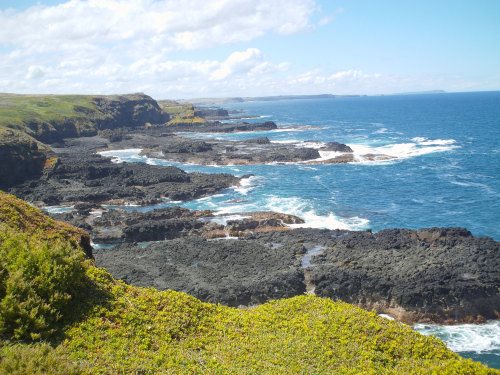
Southern Coast of Phillip Island
Swan Lake
The woodland walk at Swan Lake is probably one of the least visited
Phillip Island walking tracks but I think is actually one of the most
interesting.
A walk to the bird hides at Swan Lake is 1.3km return and takes about 40 minutes.
This is a wheelchair accessible walk through woodland, then a boardwalk over the fragile dunes and rookeries.
Information boards give a history of the area before walkers reach the bird hides.
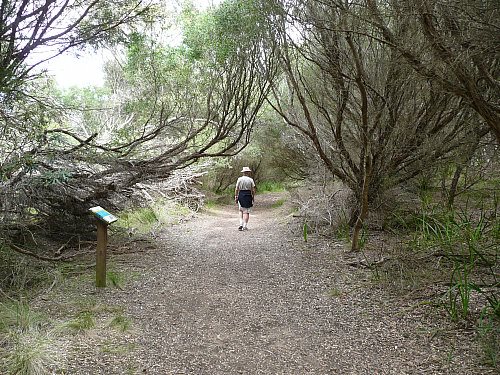
Walking Track at Swan Lake
Enjoy watching black swans and purple hen plus many other species before returning to the car park.
Sometimes the lake can be quite dry but this is just a normal seasonal event.
Beside the path you might see a short-beaked echidna out foraging for ants in the fallen logs.
Swamp wallabies are often spotted hiding in the undergrowth.
Black Swan (cygnus atratus)
Churchill Island
One of the hidden secrets of Phillip Island walking tracks is the Wadjil'garook Wetland Walk. Take the road from Phillip Island Road to Churchill Island.
Usually you will see Cape Barren geese and purple swamp hen grazing next to the road. Drive slowly to protect wildlife.
There is a car park about a kilometre in from the main road.
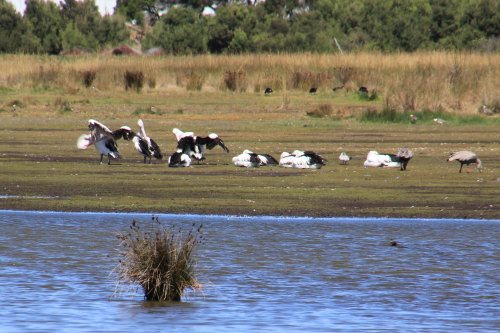
Pelicans at Fisher's Wetlands, Phillip Island
Known as Fisher's Wetland, this area is a haven for many varieties of birds. Pelicans are often seen in groups near the water holes or soaring overhead as they come in to land.
Other species such as black swans, ducks and spoon bills are attracted to this area. Numbers vary due to the season.
Follow the path from the car park to the bird hide for great viewing over the wetlands.
There are several walking tracks that meander through the woodland, with views to Churchill Island peeping through the trees.
Cross the road for a lovely walk along a boardwalk shaded by paperbarks. Further along visitors can also see bird life such as lapwings and herons.
Echidnas are sometimes seen feasting on ants on the paths near the road.
There are several information boards where visitors can learn about the Bunurong people and how they lived with the land before Europeans came.
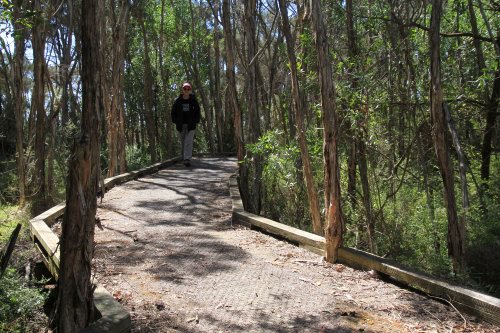
Boardwalk at Fisher's Wetland
Churchill Island itself has two popular Phillip Island walking tracks. Although entry to the historic farm is by fee, the walks are free. Both start at the visitor’s centre.
During walks remember to close all gates, stay behind fences and don’t chase animals. Try to spot a koala – there are just a few on the island.
Admire the wind-blown and twisted old Moonah trees – remnants of the island’s original vegetation with some at least 500 years old.
Information signs point out places of interest on the mainland so walkers can get their bearings. Get a new perspective on Victoria’s first farm and take in the views over Westernport Bay.
The 5km Island Loop takes about 1.5 hours. Look for birdlife such as the huge Cape Barren geese or feisty masked lapwings.
The mangroves at the southern point are part of the important breeding and feeding grounds of Westernport Bay.
North Point Loop is 2km and takes about 1 hour. Look for birds such as ibis, spoonbills, white-faced heron, great egrets, pied oyster catchers and cormorants especially when the tide is low and mud flats are exposed.
Phillip Island Heritage Walks
The Phillip Island Historical Society has put together two walks
covering historic sites of Cowes - Cowes East Walk and Cowes West Walk.
Places of interest are mostly buildings but heritage trees are also included, such as the Moreton Bay fig on the Isle of Wight Hotel site on The Esplanade, planted around 1870.
Pamphlets with information on all places of significance are available at the Information Centres at Newhaven and Cowes.
Also visit the Historical Museum in Thompson Avenue for more information on the history of Cowes and Phillip Island.

Phillip Island Heritage Walk
Ventnor Common
Off Ventnor Beach Road, Ventnor Common on Phillip Island has walking tracks through coastal vegetation.
Apart from seat for resting, there are also picnic tables for an alfresco meal.
I particularly like the wetlands boardwalk to the bird hide - this is on the other side of the road from the common.
Listen for the croak of frogs or look for swamp wallabies hiding among the trees and shrubs.
At the bird hide there is a very informative board listing birds you may see.
This is a lovely peaceful walk and a good option for small children as it is only about 150 metres to the hide.
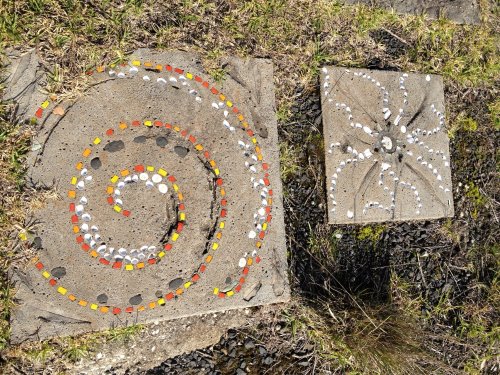
Artwork at Ventnor Common
Return to Top
Return to Home Page from Phillip Island Walking Tracks
Keep in touch - sign up for my free newsletter!
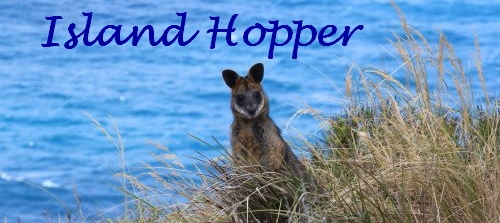
About Me Contact Me Site Map Privacy Policy
Copyright 2011-2025 phillip-island-balcony.com
All Rights Reserved
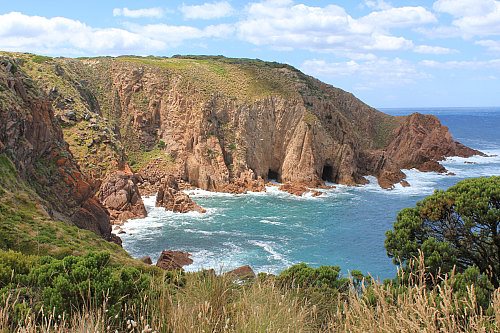


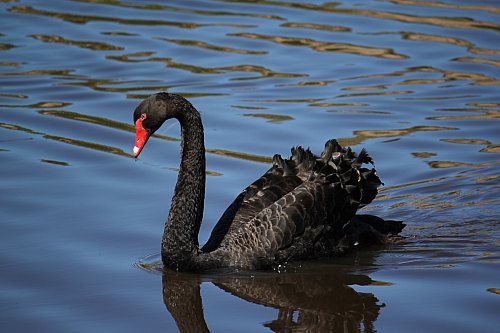
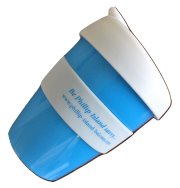
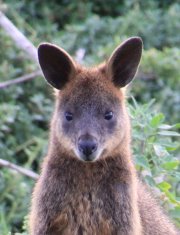
New! Comments
Have your say about what you just read! Leave me a comment in the box below.